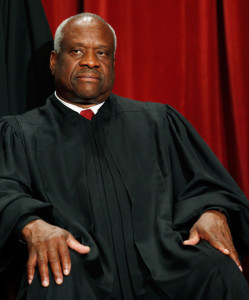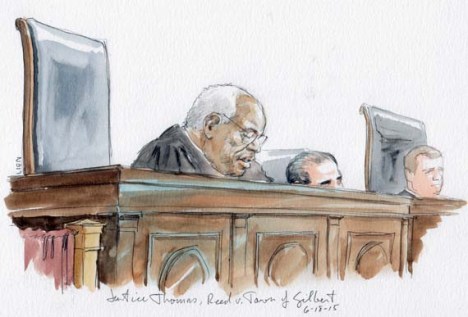On this day in history, Clarence Thomas was sworn in by Justice Byron White as the 106th Justice of the Supreme Court. Chief Justice William Rehnquist was to have sworn in Thomas during a ceremony initially scheduled for October 21, but the ceremony was postponed until October 23 because of the death of Rehnquist’s wife. In a great historical irony, Thomas was filling the seat vacated by Thurgood Marshall.
Clarence Thomas was born near Savannah, Georgia on June 23, 1948. He received a J.D. from Yale Law School in 1974. He served in a number of legal and political positions, and was nominated to the Court by President H.W. Bush.
As Associate Justice, Thomas has had an interesting career on the Court.
For example, up until 2014, eight years elapsed since Thomas asked a single question during a Supreme Court oral argument. Legal analyst Jeffrey Toobin opined:
His behavior on the bench has gone from curious to bizarre to downright embarrassing, for himself and for the institution he represents.”
This reluctance to speak in public, as well as his tendency to concur with Antonin Scalia in a great many cases, earned Thomas the sobriquet “Antonin Scalia’s sock puppet.”
On February 13, 2016, Antonin Scalia died in his sleep at the age of 79. His death may have been behind Justice Clarence Thomas’ decision to ask a question from the bench for the first time in 10 years. That same month, Thomas startled court watchers when he suddenly spoke up asking a line of questions concerning the Second Amendment. After Donald Trump’s election, he became even more loquacious, according to Thomas watcher Jill Abramson.
Possibly of greater significance where these two justices are concerned, the “New York Times” revealed that Thomas, along with Antonin Scalia, had accepted invitations to “retreats” sponsored by conservative billionaire Charles Koch for political strategizing. Nevertheless, neither of those justices recused themselves in the case of Citizens United v. Federal Election Commission (558 US 310,2010). As summarized by The Center for Public Integrity:
The Citizens United ruling, released in January 2010, tossed out the corporate and union ban on making independent expenditures and financing electioneering communications. It gave corporations and unions the green light to spend unlimited sums on ads and other political tools, calling for the election or defeat of individual candidates.”
Mr. Koch and his brother, David Koch, were among the main beneficiaries of the Supreme Court’s decision in the Citizens United case, which valorized these huge amounts of spending as an exercise in “free speech.” (More recently, ProPublica exposed a number of ties between Thomas and billionaires not limited to the Kochs with business before the Court. See this article, for example, on Thomas’s attendance at two Koch donor summits, this one on the many gifts given to him by billionaire Harlan Crow, or this one on his subsidized luxury travel.)

Photo illustration by Lisa Larson-Walker/ProPublica. Source images: Olivier Douliery/AFP/Getty Images, Chris Goodney/Bloomberg via Getty Images.
As for Thomas’s jurisprudence, Jeffrey Toobin observed about Thomas:
For better or worse, Thomas has made important contributions to the jurisprudence of the Supreme Court. He has imported once outré conservative ideas, about such issues as gun rights under the Second Amendment and deregulation of political campaigns, into the mainstream.”
His position on affirmative action, comparing its effects to those of slavery and segregation, have made liberals cringe (and no doubt have Thurgood Marshall rolling over somewhere).
Nevertheless, as Akhil Amar, a liberal professor at Yale Law School, averred – and this was before the Trump appointees joined the Court – “Thomas’s views are now being followed by a majority of the Court in case after case.”
Tom Goldstein, the publisher and co-founder of SCOTUS blog, wrote:
I disagree profoundly with Justice Thomas’s views on many questions, but if you believe that Supreme Court decision-making should be a contest of ideas rather than power, so that the measure of a justice’s greatness is his contribution to new and thoughtful perspectives that enlarge the debate, then Justice Thomas is now our greatest justice.”
Currently, Thomas is regarded as “by far the most conservative justice on a very conservative Court.” In a new book about him, The Enigma of Clarence Thomas, Corey Robin, a political scientist at Brooklyn College and the Graduate Center at the City University of New York, points out that Thomas opposes most policies that seek to combat discrimination or help minorities. Michael O’Donnell, reviewing the book, explains about Thomas: “He rejects laws and programs designed to help black people, because he views white paternalism and its attendant stigma as the greatest impediment to black advancement.”
As the New York Times observes, although Thomas downplayed his originalism at his confirmation hearing in 1991, on the court he has used originalism as a rationale for upending whole areas of American law. The author of this article on the origin and uses of “originalism” on the Court notes wryly: “It appears in retrospect that Thomas was obscuring his views in order to win Senate votes.”
Thomas, Robin writes, believes “that the best way forward for African Americans is with a clean slate, rather than clumsy attempts at redress that only add more insidious obstacles to progress.” But as Robin points out, “Every bit of reality would suggest that this is a fantasy on Thomas’s part, that the odds are overwhelmingly against African Americans, that the market clearly privileges whites.”
Thomas has also linked birth control for women to “eugenics” and reflects, according to Robin, a disdain for women.
In July 2022, Jill Abramson, co-author with Jane Mayer of Strange Justice: The Selling of Clarence Thomas, writing for FT Weekend Magazine, wrote an analysis of the Supreme Court that began with this important observation:
The US Supreme Court has suddenly lurched to the extreme right. The stunning transformation of the country’s third branch of government, which the Founders famously called ‘the least dangerous branch’, now seems anything but. Instead, with its new 6-3 conservative majority, the court, which usually moves in a slow and staid manner, has staked out radical positions on crucial issues such as abortion, guns, religion and environmental protections that are far more conservative than the rest of the country. Although he did not write any of the decisions in these contentious cases, they bear the hallmark of one justice: Clarence Thomas.”







Leave a comment